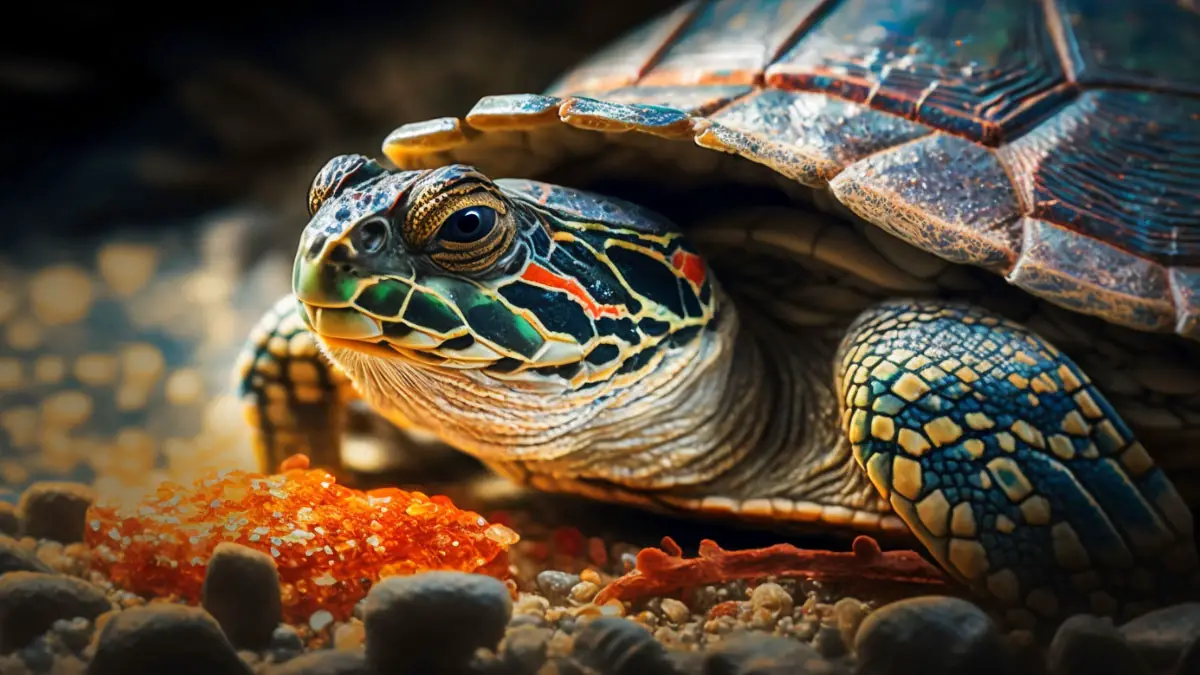Decoding the Anatomy and Physiology of Turtles
Have you ever wondered what your pet turtle’s anatomy is like? Or how its body functions and is adapted to its habitat? If yes, this guide is for you. Turtles are unique creatures known for their characteristic hard shell which compensates for their slow-paced nature to help protect them from their predators.
In this article, we’ll be taking a deep dive into the anatomy and physiology of turtles. We’ll discuss the unique structures and adaptations that enable them to survive in their environments. We’ll also look at how the anatomy and physiology of different types of turtles differ, including the aquatic and terrestrial ones.
Turtle anatomy and physiology explained
Contents
Let’s take a closer look at the key concepts of a turtle’s anatomy and physiology to give you a general idea of how its body structure and how it functions.
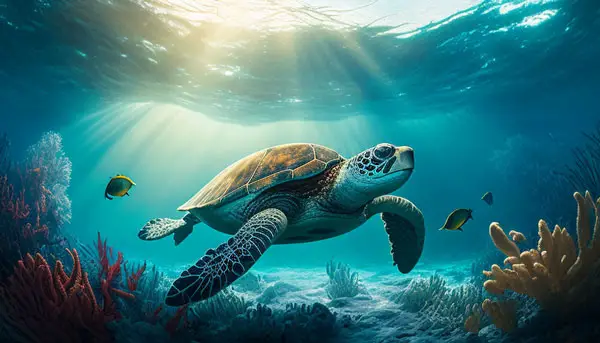
Turtle anatomy
Turtles have such a unique anatomy characterized by a hard, bony shell on their back. This shell usually comprises the upper part (known as the carapace) and the lower part (known as the plastron).
These two parts are then connected together through boney structures known as “bridges.” The shell is also fused with the spine as well as ribs of the turtle (Source).
As we hinted above, the shell is a crucial part of the turtle’s anatomy as it helps protect it against predators.
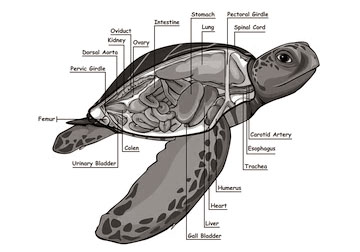
For instance, a terrestrial turtle will draw their head, limbs, and tail into its shell when it feels threatened—leaving only the hard shell for the predator, which proves too hard for it to bite.
This is the secret to their survivability in their natural habitat, so they don’t have to worry about their sluggishness being taken advantage of by their predators.
Note that the shape of the shell varies depending on the habitat of a turtle. Large turtles, including tortoises, have high-domed shells. This further makes it hard for potential predators to get a good mouth hold or grip on them.
But the pancake tortoise is an exception! Despite living on land, it has a flat shell. However, this is an adaptation that enables it to easily squeeze through small crevasses between the rocks in their habitats.
The aquatic and sea turtle species, on the other hand, have their shells lay slightly lower to help reduce drag and make swimming through water much easier.
Other notable features of a turtle’s anatomy include up to four limbs whose shape varies depending on the environment.
They also have sharp beaks instead of teeth, which helps with biting. The beak is made of keratin, the same material that makes up your nails and hair.
Turtle physiology
The physiology of the turtle is also unique, especially due to the presence of a hard shell on its back and the fact that these reptiles are endothermic in nature.
For this part, we’ll briefly touch on the respiratory, digestive, and cardiovascular systems of turtles.
Respiratory system
Turtles are capable of breathing both in water and on land. They have well-developed lungs that allow them to breathe in oxygen in the air.
But they also have a cloaca gland that allows for cloacal respiration when they’re submerged in water.
Through this gland, they’re able to draw oxygen from and release carbon dioxide into the water. Ever heard of butt-breathing in turtles? This is it!
Digestive system
Turtles also feature an elaborate digestive system that enables them to extra as many nutrients as possible from various foods it eats.
They don’t have teeth, so they depend on their beaks to break down food into small pieces for easy swallowing.
Aquatic turtles also require water for them to eat their food due to their salivary glands adaptations.
Much of a turtle’s digestive system is similar to that of other animals, where food transits including the esophagus, stoma, small intestine, large intestine, and finally fecal matter are passed through cloaca.
Note that the transit period for food can take as turtles have a slower metabolism. It can be affected by the temperature, water content, fiber, and even the feeding frequency.
Cardiovascular system and heat exchange
Turtles are ectothermic or cold-blooded, meaning they can’t regulate their own body temperature. Instead, they rely on the surrounding environment temperature to adjust their body temperatures.
This explains why turtles in the wild often bask in the sun, as they seek external heat sources to help keep their body temperature at optimum range so that their vital organs can function properly.
The reptiles also have a complex circulatory system for circulating blood throughout their bodies.
The system is pretty much like that of other animals and includes the heart, blood vessels, and a variety of specialized structures for maintaining blood pressure as well as oxygen levels.
Aquatic vs Terrestrial Turtles Anatomical and Physiological Differences
Terrestrial and aquatic turtles have notable anatomical and physiological differences that enable them to survive in their respective environments.

Some of these key differences include:
- Shell shape: The shell of terrestrial turtles is domed and heavier to help offer protection against predators while that of water turtles is flatter and more streamlined to enable them to easily move through the water.
- Limbs: The limbs of land turtles are sturdy and strong to enable them to walk and dig on the land while their aquatic relatives have flattened, paddle-like limbs for increased swimming prowess.
- Claws: Aquatic turtles have sharper and longer claws to offer them a good grip on logs, rocks, slippery stones, and muddy embankments in water. They’re also webbed for increased swimming efficiency. Land turtles have dull claws which allow for easy walking on the land.
- Diet: Land turtles are generally omnivorous and will feed on both plant and animal materials. Aquatic turtles vary between carnivorous, herbivorous, and omnivores, depending on the species.
Unique turtle adaptations that enable turtles to survive in their environment
Just like other animals, turtles have unique adaptations and structures that enable them to survive in their environments.
The shell is one such structure that helps keep these reptiles safe from predators.
Some species like the snapping turtle have strong, knobbed tails which further enable them to defend against predators.
Mud turtles hinged shells enable them to easily draw in their extremities completely inside their shells. This brings the shell bottom all the way up so that it touches the top, resulting in a solid sheet form of protective covering.
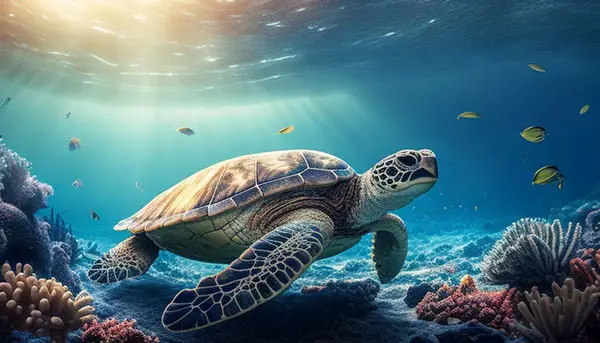
Sea turtles have pretty lightweight shells, an adaptation that enables them to swiftly swim away from predators.
Freshwater and sea turtles have webbed feet to enable them to swim efficiently in water. In addition, they have extended claws that make climbing logs and rocks in the water easy.
When it comes to terrestrial turtles, they’re equipped with strong and sturdy legs that make it easy for them to walk as well as dig in the ground.
Some land turtles also feature longer necks to enable them to easily reach for food that’s a bit higher off the ground.
Softshell unique adaptations:
Softshell turtles feature flexible, leathery skin in place of a hard shell, making them more flexible and agile while in water. This enables them to hunt and escape predators easily.
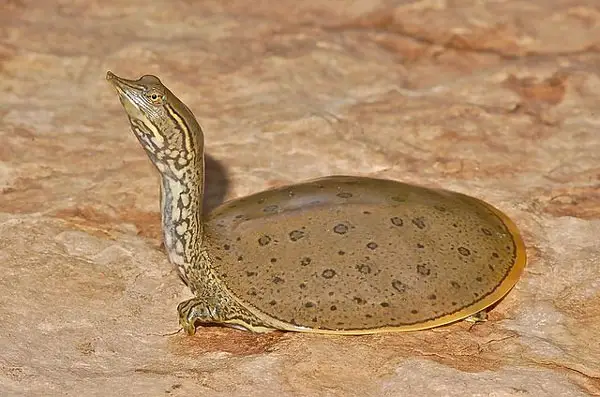
They also have a flat and pancake-like shape to further enable them to move easily through water, making them some of the most powerful swimmers in the turtle family.
Softshells also feature highly vascularized skin that makes it easy for them to directly extract oxygen from water.
Final Verdict
Now you know the anatomy and physiology of different turtle species. These creatures have distinctive hard shell on their back that gives them protection against predators. For physiology part, they have elaborate digestive, respiratory, and cardiovascular systems, just like other animals.
However, as we’ve discussed in the above guide, there are notable differences between the aquatic and terrestrial turtles’ anatomy and physiology including shell shape, limbs, feet, and even diet. These differences are unique adaptations that enable the turtles to survive in their respective environments.


